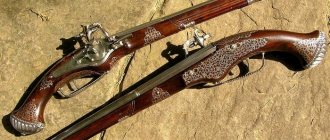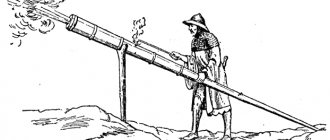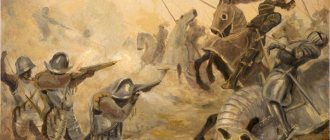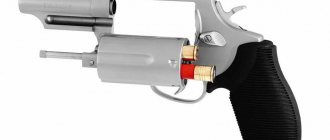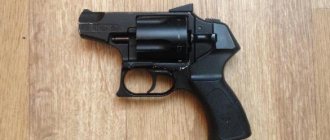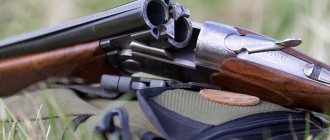Handguns in Europe and Russia of the 15th-19th centuries
The time and place of the invention of gunpowder are not precisely known: most likely, it appeared in China, and then became known to the Arabs; In Europe, gunpowder began to be used in the 13th century. With the invention of gunpowder, the creation of firearms became possible.
One of the first types of handguns, used back in the 12th-13th centuries. there was an Arab modfa, which was a metal barrel attached to a shaft. The modfa was used to fire a bondoc, a projectile made from a mixture of saltpeter, coal and sulfur, enclosed in a metal casing.
Hunting seven-shot rifle-revolver with a flintlock. Tula, 1790
In Western Europe and Rus', firearms have been known since the 14th century. The earliest of all types of handguns in Europe was the smoothbore gun, which first appeared in the 14th-15th centuries. The charge in this weapon was ignited by a wick or a red-hot metal rod. Early hand-held firearms included arquebuses, arquebuses, and culverins. In the 16th century, after the invention of the matchlock, trigger and trigger, more advanced guns appeared - muskets - which were used by the infantry, as well as pistols. In the 17th century, handguns began to be equipped with a bayonet. Since the end of the 17th century, smooth-bore flintlock guns loaded from the muzzle have become widespread in Russia and Europe. In the 19th century, smoothbore guns were replaced by rifles - guns with screw rifling in the bore (smoothbore guns survived only as hunting weapons). The first rifled guns - fittings - were known back in the 16th century, but were not widely used due to imperfect design. At the end of the 19th century, after the invention of smokeless gunpowder, automatic small arms appeared in service.
Five-shot revolver according to the Smith and Wesson system, designed to look like a Caucasian pistol. Tula. 1875-1880
One of the first types of Western European handguns was the arquebus, which came into use in the first third of the 15th century. From the arquebus they fired first stone and then round lead bullets, loaded it from the muzzle, and ignited the powder charge through a special hole in the barrel. In service with Russian troops in the XV-XVII centuries. there was a arquebus. Hand-held arquebuses, used for defense and in field combat, could be single-barreled or multi-barreled, short or long. In addition, there were large arquebuses used for siege or defense of fortresses.
The musket first appeared in Spain at the beginning of the 16th century, and from there it spread to Germany, France and Russia. The musket was a rather heavy weapon (it weighed about 8-10 kg) and gave strong recoil when firing, so initially only selected detachments of musketeers specially trained and equipped for this were armed with muskets (when shooting, they put a special leather pillow and a sling with a bag on their shoulder for bullets and fuse, as well as 12 measures for charges). The musket was in active use for just under two centuries: at the end of the 17th century, first in France and then in other European countries, it was replaced by more convenient flintlock guns. (In Russia, until the beginning of the 19th century, flintlock guns were called “muskets”).
Flintlock guns were in service with Russian and European armies in the 17th-19th centuries. They had a caliber of 17.5-21.5 mm and weighed from 4 to 6 kg. In flintlock guns, the charge was ignited using sparks generated by the flint when it struck a flint plate; the shot range ranged from 140 to 800 m. In the mid-19th century, the armies of Russia and all European countries replaced flintlock guns with rifles.
Pistols with flintlocks. 1640-1650 Moscow, workshops of the Armory Chamber
The first samples of rifles date back to the 16th century, however, then the rifle, despite its long range (up to 2000 m) and shooting accuracy, did not catch on. The problem was that, due to the difficulty of loading from the muzzle, the rate of fire of the rifle was 5-6 times inferior to smoothbore weapons (if a flintlock smoothbore gun could fire one shot per minute, then from a rifle with a screw thread - one shot per five minutes ).
In the 17th-18th centuries, screw-rifled guns were used only by the best shooters or existed as serf guns. In the 19th century, after the invention of the percussion composition of the primer, the unitary metal cartridge and the improvement of the charging method (from the breech), the rate of fire of rifles increased significantly. This contributed to the fact that in the middle of the 19th century the rifle was adopted by all advanced armies. In Russia in 1868, the “Berdanka” rifle was adopted - the Berdan No. 1 rifle (developed by the American colonel H. Berdan), which was improved by engineers A.P. Gorlov and K.I. Gunnius. In 1870, the faster-firing Berdan No. 2 rifle was adopted, and in 1891, the S.I. Mosin repeating rifle was adopted, which served, subject to minor changes, for about 60 years. The rate of fire of the Mosin rifle was 10-12 rounds per minute, and the effective firing range was up to 2000 meters. With the invention of automatic weapons, the automatic rifle was developed.
A lightweight and shortened rifle - carbine - was in service with cavalry and artillery from the 18th century to the first half of the 20th century. The predecessor of the carbine was invented at the end of the 15th century. In the 15th century, light infantry and cavalry were called carabinieri in Spain, and in France in the 16th century. There were special privileged units of the Carabinieri in the 18th century in Prussia, Russia, and Austria.
Pistols with flintlocks. 1640-1650 Moscow, workshops of the Armory Chamber
Automatic firearms first appeared in the second half of the 19th century: in 1863, the American R. Pilon designed an automatic gun. In Russia, the first project of an automatic rifle was created in 1887 by D.A. Rudnitsky. At the beginning of the 20th century, the Madsen semi-automatic light machine gun (1902) and the heavy machine gun, invented in 1883 by the American H. Maxim, became widespread. In particular, both sides used such weapons during the Russian-Japanese War of 1904-1905. In 1910-1911 In Russia, automatic rifles of the V.G. system were designed and tested. Fedorova, F.V. Tokarev and others. The automatic rifle made it possible to fire 25-30 rounds per minute with a single fire.
The first pistols that made it possible to hit an enemy at a distance of 50-70 m and fire with one hand appeared in Europe and Asia in the 16th century - these were matchlock pistols, which were used mainly in cavalry. In the 17th century, pistols with flintlocks became widespread in different countries, and from the 19th century - with capsule locks (1835, S. Colt). The most common were single- and double-barreled pistols, but more barrels were also found. Until the mid-19th century, smoothbore pistols were in service, loaded from the muzzle. Since the middle of the century, they have been replaced by rifled multi-shot revolvers with a rotating drum magazine. The Russian army was armed with Smith-Wesson revolvers of the 1871, 1874 and 1880 models, which at the end of the 19th century were replaced by Nagant revolvers of the 1895 model.
Six-shot revolver-carbine of the Colt system. On the barrel there is a stamp with the Tula coat of arms and the inscription: “TULA GUNMAKERS”. Tula, ok. 1855
After its invention in the 1880s. Smokeless gunpowder and the use of a unitary cartridge with a metal sleeve gave rise to rapid-fire automatic pistols, which gradually replaced revolvers as weapons. The first automatic pistols of J. Browning appeared in 1897, the automatic pistol of Wilhelm and Paul Mauser - in 1896 (in 1866 they designed a single-shot rifle and revolver, which were adopted by the German army in 1871). An automatic pistol (1911) and a revolver (1917) were developed.
The bayonet appeared in the middle of the 17th century in France. Initially, it was a shortened spear, the shaft of which was inserted into the bore of the gun, and at the end of the century they began to make all-metal bayonets with a tube mounted on the barrel, which made it possible to load the gun and shoot from it without removing the bayonet. In Russia, the bayonet was adopted at the beginning of the 18th century.
The production of handguns in Russia and Europe in the 16th-17th centuries was carried out by single craftsmen or craftsmen united in guild organizations. In the XVIII-XIX centuries. handguns are produced at arms factories, of which the most famous in Russia were the Tula, Olonets, Sestroretsk and Izhevsk factories. The leading role in the manufacture of both military and artistic firearms belonged to the Tula Arms Factory, whose craftsmen constantly worked to improve the production and design of products. In Russia in the 18th-19th centuries, attention was paid to the creation of weapons schools, with the aim of training qualified personnel to work in factories and with the troops.
To the beginning of the “Weapons” section>>>
United army - single caliber
It took a decade and a half to solve this problem. Let's say, the spread of calibers of soldier fuzes of the 1707 model reached two millimeters, the spread of length was about 20 centimeters, and the weight varied within two kilograms! In order to somehow unify the weapons, it was necessary to specially sort fuses by caliber and length, collecting company batches: on the scale of one company it was possible to ensure the casting of bullets of the same caliber. So even during the Battle of Poltava, the Russian army had to fight with hand-held firearms, albeit fairly uniform in type, but very diverse in caliber. However, this patchwork of calibers and weapon designs also played a role: as a result, based on the experience of combat use, it was possible to develop the requirements and characteristics of the fusee, which finally became a single type of weapon for the Russian infantry and cavalry of the 18th century.
Fusées of a single type were finally introduced into the Russian army by decree of Peter I of May 24, 1715. According to this document, the caliber of the weapon was set at 19.8 mm, or 0.78 inches, and the average weight was within a little over five kilograms. It was never possible to standardize this indicator: it strongly depended on what kind of wood was used to make the fusée stock. For example, an elm stock made the fusee the lightest, less than five kilograms, and with an ash stock it weighed almost six. But a single caliber was much more important than equal weight, and therefore at arms factories, primarily in Tula, standard cylinders were introduced, with the help of which the diameter of the bore was measured. It became possible to introduce uniform requirements for ammunition under a single caliber. The weight of the powder charge for one shot was now 12.8 grams, and the weight of the round bullet was 33 grams.
Fuseler of the Life Guards Preobrazhensky Regiment, from 1700 to 1720. The view depicts part of the city and fortress of Narva, conquered by Russian troops in 1704. Drawing from the monograph by Alexander Viskovatov “Historical description of clothing and weapons of the Russian troops, with drawings, compiled by the highest order,” 1841-1862.
Source: memorandum.ru
Guns for infantry and cavalry
Since 1715, the overall dimensions of the fuses have also become uniform, although they depended on which units the weapons were intended for. The longest were infantry fuses: barrel - 1016 mm, total length - 1422 mm. Moreover, this was the length without taking into account the bayonet, which added about forty centimeters to the fusee. By this time, the Russian army had already abandoned baguettes - blades that were inserted directly into the barrel, as on the first examples of Peter the Great's fuses. Now these were bayonets, flat or triangular, mounted on the front of the barrel using a special tube and did not interfere with firing. Dragoon fusées, intended to arm cavalry capable of fighting both on horseback and on foot, did not have bayonets, but received a shoulder strap for attaching to a sling during a race. In addition, they were shorter and lighter than infantry ones: the barrel length was less than a meter, the weight was within 4.5 kg, but the caliber remained the same - 19.8 mm.
The loading system for both infantry and cavalry fuzes of all types was the same. To prepare for a shot, the soldier had to take a paper cartridge with gunpowder and a bullet in his bag, bite the corner and pour some gunpowder onto the charging shelf, which was then closed with a flint lid. The rest of the gunpowder, along with the paper, was sent into the barrel, the bullet was also dropped there, and the whole thing was compacted with a ramrod. After this, the shooter pressed the butt to his shoulder and pulled the trigger, the trigger dropped, the flint moved the flint, opening the ignition shelf and igniting the gunpowder on it, after which the fire penetrated the barrel through the ignition channel - and after 2-3 seconds a shot was fired. The process was slow: an experienced soldier could fire from three to six shots per minute, but the average rate of fire did not exceed one shot per minute. Each infantryman was entitled to 50 bullet charges and another 20 charges of buckshot, the weight of which was equal to the weight of the bullet, and the dragoons were entitled to 40 charges.
Fuseler of the Dragoon Regiment, from 1700 to 1720. Drawing from the monograph by Alexander Viskovatov “Historical description of clothing and weapons of the Russian troops, with drawings, compiled by the highest order,” 1841-1862.
Source: memorandum.ru
